Harlow Hill Cemetery
Harlow Hill Cemetery on Otley Road, Harrogate, North Yorkshire, England, is a local authority cemetery established on land donated by Henry Lascelles, 4th Earl of Harewood in 1869, and consecrated on 3 October 1871 by the Bishop of Ripon. It features the Gothic Revival Church of All Saints, designed by Isaac Thomas Shutt and Alfred Hill Thompson. It has individual memorials to casualties of World Wars I and II, and other graves include those of actor Michael Rennie and Catherine Gurney, an activist in the Temperance movement in the United Kingdom.[1]
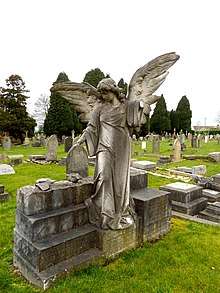 Harlow Hill Cemetery | |
| Details | |
|---|---|
| Established | 3 October 1871 |
| Location | Otley Road, Harrogate |
| Country | England |
| Coordinates | 53°58′50″N 01°33′53″W |
| Type | Public, Anglican, War graves, memorial |
| Owned by | Harrogate Borough Council |
| Website | HBC: Harlow Hill Cemetery |
| Find a Grave | Harlow Hill Cemetery |
Location and general information
Harlow Hill Cemetery is on the north side of Otley Road, near RHS Garden Harlow Carr in Harrogate. It is run by Harrogate Borough Council;[2] It was established in 1869 on land donated by the Earl of Harewood.[3] Although the church was opened on 11 April 1871, the church and cemetery could not be consecrated until 3 October of the same year due to a financial anomaly.[4][5][6]
History
Early history
Harlow Hill is the earliest recorded place of worship in Harrogate. It is likely that a chantry chapel existed on this hill in the 14th century. Harrogate Chantry Chapel is first mentioned in a will of 1439 and was dissolved in 1549. A high cross known as the Great Puddingstone Cross existed close by the site of the chapel from at least 1199, and was gone by 1610.[7] By 1848 there is no mention of a church or cemetery on Harlow Hill.[8]
Recent history

In 2000 at Grove Road Cemetery, Harrogate, a 99-year-old, 2-metre (6.6 ft) high monument fell and killed Reuben Powell aged six years.[5][9] Harrogate Council responded by contacting those owners of graves who were traceable to ask them to secure their standing stone memorials. Between 2006 and 2010, 6,000 standing monuments with untraceable owners were laid down for safety reasons by the Council. During the same period, "scores of Harrogate district offenders, sentenced to Community Payback" assisted with the reinstatement of over 1,000 of the laid-down memorials. Councillor Les Ellington said, "Not only is this bringing benefit to local communities, who are seeing their cemeteries reinstated, it is saving public funds ... over 60 offenders have also been accredited by York College of Masonry with Open College Network qualifications."[9]
Chapel

The plot of land for the chapel and cemetery was donated by Henry Lascelles, 4th Earl of Harewood (1824–1892), and the church was opened in 1871.[10] The chapel was designed by Isaac Thomas Shutt and Alfred Hill Thompson ARIBA, architects.[11][12][13]
Notable burials
Individual war memorials
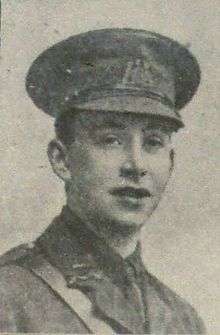
The Commonwealth War Graves Commission has identified 28 casualties recorded here.[14] There are various individual gravestone-memorials to those killed in World Wars I and II, and the cemetery has been photographed and indexed with war memorials noted.[15][16]
For example, Donald Luke Abbott (1920–1943) was a prisoner of war in Japanese hands, he was buried at Thanbyuzayat, Burma, in the war cemetery commemorating those who died constructing the Burma-Siam Railway.[17] The stone cross for the Beall family records two brothers killed in action in 1917 and 1916. They are Lieutenant A. Ernest Beall of the King's Own Yorkshire Light Infantry and Lance Sergeant Wilfred R. Beall of the York and Lancaster Regiment.[18] The Campbell stone cross monument records the death in France of Private William Gordon Campbell (1887–1917) of the 46th Battalion of the AIF, or First Australian Imperial Force.[19] The gravestone of the Crawford family tells of Geoffrey Crawford, his parents' only son, who was killed in action in Sumatra in 1942.[20] Fred Foxton, ABRN, (1919–1944) is recorded as missing presumed killed at sea; his sister had already died suddenly at the age of 26.[21] The portrait of Ordinary Seaman Kenneth Mattison RN (1922–1942) C/JX 318042 in sailor's uniform is on his white gravestone; he died at age 19 years of wounds received in action at sea on 17 August 1942.[22] Captain John K. Miller MC was a captain in the Denbighshire Hussars and attached to the Royal Welch Fusiliers. He was killed in action in 1918 near Roussoy, France, and buried in the British cemetery northwest of St Quentin.[23][24]

Walter Ranson (Hawke) Oliver (1894–1918) of the 63rd (Royal Naval) Division was killed in action; his monument is a stone cross.[25] Lieutenant Roy Balfour Hodgson Rayner (1893–1916) (pictured) of 15th West Yorkshire Regiment died of wounds in France on 24 May 1916. He was wounded by shrapnel while trying to rescue wounded members of a wiring party.[26][27] Lieutenant Elwyn George Renton (1886–1918) RASC, attached to the Imperial Camel Corps, died of pneumonia at the Station Hospital, Lahore on 29 May 1918. In peacetime he was a solicitor.[28][29][30] Two brothers from the Wooler family died in action, and their monument is a white marble cross. 2nd Lieutenant (active Captain) Charles Armitage Wooler (1895–1916) was in the West Yorkshire Regiment; he was wounded while leading his men into action at the Battle of the Somme, and died at Woolwich Hospital. His brother 2nd Lieutenant Herbert Sykes Wooler 2nd lieutenant of the Royal Artillery (Cantae: Intelligence Officer) of the 12th West Yorkshire Regiment (1893–1916) is buried at Lissenhuek Military Cemetery, Poperinge, Belgium.[31]
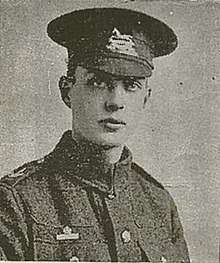
Captain T.W. Youngs of the Border Regiment survived active service and died in 1917.[32] Recorded in plot H.69 is Davis Welby (1875–1918) (pictured), Second Lieutenant of the Royal Garrison Artillery, and previously no. 4539 in the Artists Rifles. He died in Ireland. Private James Alexander Fairley (1896–1916) belonged to the Saskatchewan Regiment of the 1st Battalion, Canadian Mounted Rifles, CEF.[33][34] Private Selwyn Lupton (1896–1916) 1380 1st/5th West Yorkshire Regiment (pictured) died on 20 January at Wharncliffe War Hospital, Sheffield, from wounds sustained at Ypres on 20 December 1915, having served in France since April 1915. He had the British War and 1915 Star medals.[35][36] Private Francis Cecil Yates 2093 of 1st/5th West Yorkshire Regiment (now Prince of Wales's Own), from Hookstone Road, Harrogate, was killed in action at Ypres on 28 September 1915 aged 23.[37] Private Clifford Wheeler 235865 of 9th Battalion West Yorkshire Regiment, formerly 330615 Yorkshire Hussars Yeomanry, from West Lea Avenue, Harrogate, died on 9 October 1917 aged 23.[38]
Burials and in memoriams
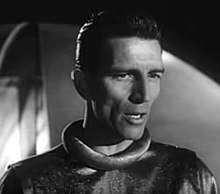
The ashes of actor Michael Rennie (1909–1971) are buried in section F, plot 21 under his birth name Eric Alexander Rennie. He is remembered in particular for his role as Klaatu in the 1951 film The Day the Earth Stood Still.[9][39][40] The stone cross monument for Thomas Roger Carr in section F records two premature deaths: Carr (1899–1926) was killed in an accident, and his father Thomas (1858–1911) was lost at sea.[41] The Louise Clark stone cross monument records Moorhouse Clark (1872–1935), who was the classical master of Denstone College for twenty years, then vicar of Croxton and Hollington for eleven years.[42][43][44] Catherine Gurney (1848–1930) was the founder in 1883 of the International Christian Police, and founder in 1898 of the Northern Police Orphanage in Harrogate, besides being an activist in the Temperance Movement.[1] Her original headstone has been replaced with a new black marble one.[45][46][47] Alfred Mantle (1846–1924) was a physician; his monument is a stone cross.[48] Carle Mumme (1838–1919) was a shipbuilder from Dungallon, Greenock; he has an elaborate memorial of an angel and cross.[49] James Walter Nuttall (1862–1928) was headmaster of Clifton House School, 6 Queen Parade, Harrogate, and his monument is a carved Celtic cross.[50][51]
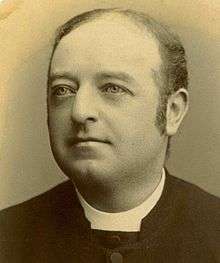
Charles Farrar Forster (1848–1894) was the first vicar of Beckwithshaw Church, dedicating himself to parochial work despite severe pain due to heart disease.[52][53][54] Gertrude Alina Paitson (1880–1921) was a nurse; her monument is a stone cross.[55] Emily Perry, a nanny who died in 1941, was buried under a stone Celtic cross in the same grave as the family she cared for at Grey Court, 57 Kent Road, Harrogate, the residence of John Joseph Prest (1859–1933), JP.[56] Arthur Vasey Thomas (1906–1930) of Nitter Hill and Oakdale Farm, Penny Pot Lane, Harrogate, died in a road accident. He overtook a motor-bus and hit a bus coming the other way, near Pateley Bridge.[57][58] Samuel George Mower Webb (1843–1929) was rector or vicar of All Saints Church, Saxton with Scarthingwell (1878–1903), of St Mary the Virgin, Kirk Fenton, West Yorkshire (1903–1911), and of St Andrew's Church, Newton Kyme (1911–1912).[59][60] Atherton West (1954–1923) was a weaving master of Elgin Mills, Kanpur, who founded Victoria Mill, now Atherton Mills, in Kanpur, India in 1885.[61][62] John Arthur Green (d.1926) was one of the founder members and first secretary of the Yorkshire Ramblers' Club, and a runner in Leeds Harriers in the late 1880s. He worked for the North Eastern Railway, and for Beckett's Bank. He was manager in turn of Leeds, Mansfield and Harrogate branches of the Yorkshire Penny Bank. He was a climber and potholer, and was one of the first party to descend Pillar Pot and Rift Pot.[63] Margaret Ingilby or Ingleby (1827–1894) was one of the Ingilbys of Lawkland Hall, Lawkland, who in turn were related to the Ingilbys of Ripley Castle.[64][65][66]
References
- Clara Christiana Morgan Chapin, Thumb Nail Sketches of White Ribbon Women, Woman's temperance publishing association (1895), p.17
- Harrogate Borough Council: Cemeteries, Harlow Hill
- "The Earl of Harewood". Bradford Daily Telegraph. 13 November 1869. p. 3 col3. Retrieved 26 February 2019 – via British Newspaper Archive.
- "Harrogate, opening of a new church". Yorkshire Post and Leeds Intelligencer. 12 April 1871. p. 3 col4. Retrieved 26 February 2019 – via British Newspaper Archive.
- "Cemetery controversy finally laid to rest?". Harrogate Advertiser. 23 July 2009. Retrieved 26 February 2019.
- Harrogate Bereavement Guide: online leaflet p.11 Confirms date of opening as 2 October 1871
- Neesam, Malcolm. "The history of worship on Harrogate's Harlow Hill with historian Malcolm Neesam". Ripon Gazette. Retrieved 26 February 2019.
- British History Online: A Topographical Dictionary of England, Harrogate Retrieved 14 March 2014
- "Offenders praised for helping reinstate cemetery memorials". Yorkshire Post. 21 July 2009. Retrieved 26 February 2019.
- "Opening of a new church at Harrogate". York Herald. 15 April 1871. p. 10 col4. Retrieved 26 February 2019 – via British Newspaper Archive.
- See the foundation stone in this image: File:All Saints Harlow Hill 029.jpg
- British Listed Buildings: Church of All Saints, Harrogate, 329899 Retrieved 10 March 2014
- Historic England. "Church of All Saints, Otley Road (1294025)". National Heritage List for England. Retrieved 29 January 2019.
- Commonwealth War Graves Commission: Harrogate HHC Retrieved 10 March 2014
- Gravestonephotos.com: Cemeteries within Harrogate that have been photographed and indexed Retrieved 17 March 2014
- Yorkshire Indexers: Harrogate, Harlow Hill Retrieved 10 March 2014
- Gravestonephotos.com: Donald Luke Abbott grave monument, section F, no.1 Retrieved 17 March 2014
- Gravestonephotos.com: George Beall grave monument, section F, no.25 Retrieved 17 March 2014
- Gravestonephotos.com: Thomas Campbell grave monument, section F, no.50 Retrieved 17 March 2014
- Gravestonephotos.com: George Frederic Crawford grave monument, section F, no.66 Retrieved 17 March 2014
- Gravestonephotos.com: Annie Foxton grave monument, section F, no.96 Retrieved 17 March 2014
- Gravestonephotos.com: Kenneth Mattison grave monument, section F, no.186, grave 115 Retrieved 17 March 2014
- Roussoy is possibly Roissy-en-France
- Gravestonephotos.com: John K Miller grave monument, section F, no.191 Retrieved 17 March 2014
- Gravestonephotos.com: Albert Oliver grave monument, section F. no.202 Retrieved 17 March 2014
- Gravestonephotos.com: John Hodgson Rayner grave monument, section F, no.223 Retrieved 17 March 2014
- Yorkshire Indexers: Rayner, Roy Balfour Hodgson Retrieved 17 March 2014
- Gravestonephotos.com: George Renton grave monument section F, no.226 Retrieved 17 March 2014
- Angelfire: United Kingdom & Former Colonies WW1 Retrieved 17 March 2014
- Angelfire: 1918 Harrogate newspaper extracts Retrieved 17 March 2014
- Gravestonephotos.com: Herbert Sykes Wooler grave monument, section F, no.311 Retrieved 17 March 2014
- Gravestonephotos.com: Elizabeth Youngs grave monument, section F, no.316 Retrieved 17 March 2014
- Interred in grave C.156
- Veterans Affairs Canada: Canada virtual war memorial Retrieved 14 March 2014
- Wharncliffe War Hospital: Selwyn Lupton 14 March 2014
- Interred in plot G.277
- War Graves Photographic Project, Yates Francis Cecil
- The War Graves Photographic Project: Wheeler, Clifford 14 March 2014
- Yorkshire Reporter: Remembering Michael Rennie Retrieved 23 February 2019
- nndb: Michael Rennie Retrieved 14 March 2014
- Gravestonephotos.com: Thomas Roger Carr grave monument Retrieved 17 March 2014
- Gravestonephotos.com: Louise Clark grave monument Retrieved 17 March 2014
- Church of England: St Paul's Church, Croxton Retrieved 17 March 2014
- The Church of England: Hollington S.John the Evangelist, Hollington Retrieved 17 March 2014
- Gravestone photos.com: Catherine Gurney grave monument, section F, no.109 Retrieved 17 March 2014
- St George's House: The story of St George's House, Harrogate Retrieved 10 March 2014
- London Christian Police Family: About us
- Gravestonephotos.com: Alfred Mantle grave monument, section F, no.180 Retrieved 17 March 2014
- Gravestonephotos.com: Carl Mumme grave monument, section F, no.195 Retrieved 17 March 2014
- Aedenplus.com: James Walter Nuttall Retrieved 17 March 2014
- Gravestonephotos.com: James Walter Nuttall grave monument, section F, no.200 Retrieved 17 March 2014
- Gravestone photos: Harlow Hill Cemetery, Harrogate, section A, grave no. 170999, Charles Farrar Forster Current reference for grave location is Section A, grave no. 28. Directions: enter cemetery's main gate; grave is in 7th row (parallel with street) on left of path, 1st grave in row, by tree.
- "Deaths". Yorkshire Evening Post. 31 August 1894. p. 2 col4. Retrieved 26 February 2019 – via British Newspaper Archive.
- The grave plot is owned by the descendants of Mark Rowntree (1838–1923), vicar of St Robert's Church, Pannal. Information from Stonefall Cemetery office Archived 14 November 2013 at the Wayback Machine
- Gravestonephotos.com: Gertude Alina Paitson grave monument, section F, no.205 Retrieved 17 March 2014
- Gravestonephotos.com: John Joseph Prest grave monument, section F, no.218 Retrieved 17 March 2014
- "Harrogate farmer killed". Leeds Mercury. 23 September 1930. p. 5 col6. Retrieved 26 February 2019 – via British Newspaper Archive.
- Gravestonephotos.com: Arthur Vasey Thomas grave monument Retrieved 17 March 2014
- Gravestonephotos.com: Samuel George Mower Webb grave monument, section F, no.289 Retrieved 17 March 2014
- Webb one name register Retrieved 17 March 2014
- Gravestonephotos.com: Atherton West grave monument Retrieved 17 March 2014
- Amiya Kumar Bagchi, Private Investment in India, 1900–1939 (Taylor & Francis, 2000) Retrieved 17 March 2014
- YRC: In memoriam Retrieved 10 March 2014
- See image of Lawkland Hall: File:Lawkland Hall - geograph.org.uk - 176703.jpg
- Ingilby History: Part II, Ingilby of Lawkland Retrieved 14 March 2014
- The National Archives: Ingilby of Lawkland Retrieved 21 March 2014
External links
| Wikimedia Commons has media related to Harlow Hill Cemetery. |
| Wikimedia Commons has media related to Church of All Saints, Harlow Hill. |
- Gravestone photos: A list of monuments in section F of Harlow Hill Cemetery Retrieved 10 March 2014
- Billion Graves: Satellite map of Harlow Hill Cemetery To access, write "Harlow Hill Cemetery" in search box
- Borthwick Catalogue: Cemetery Research Group photographic archive